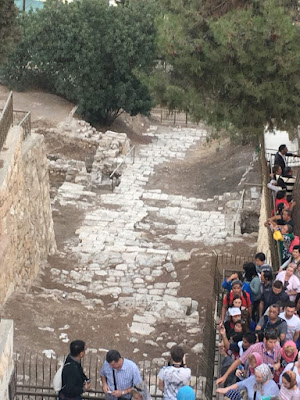As I was preparing this blog about the 7th day of our Holy Land Pilgrimage, I prayed for inspiration on how I can make a cohesive thread for the places we visited. At first glance, our itinerary for Jerusalem seemed quite random. God inspired me to write this poem by following the path we took.
Deny not His friendship lest life be hollow.
Then I saw how clearly He had ordered that day.
Jesus left His footprints for us to
follow.
Our morning was spent in the Mount of Olives. First stop was the Chapel of the Ascension. It is believed to be the spot where Jesus ascended into heaven.
Inside this small chapel is a slab
of stone called the Ascension Rock. Pilgrims venerate this rock because it is said to
bear the impression of Jesus’ right footprint.
He taught us to keep Our Father’s
name hallow.
Next, we visited the Church of the Pater Noster.
Tradition holds that Jesus taught
His disciples the Our Father in this grotto under the church.
The church’s cloister displays
colorful ceramic plaques on the walls bearing the Lord’s Prayer in 140
languages and dialects including one in Tagalog.
Then we made our way down the extremely
steep Palm Sunday Road. This is where Jesus’ Triumphal Entry into Jerusalem
took place. (Tip for super senior pilgrims: make sure you have an able-bodied
companion who can help you walk down safely. A very helpful community brother
had to hold on to Papa’s leather belt so he wouldn’t do a Jack and Jill tumble
down the hill.)
Under the olive trees, He poured
out His sorrow.
Midway down the road is a quaint teardrop-shaped church called the Dominus Flevit (Latin for “The Lord wept”) where we heard mass.
 |
| Jerusalem with the imposing Dome of the Rock as viewed from the Dominus Flevit picture window right behind the altar |
At this spot, Jesus wept over the
future destruction of Jerusalem. The shape of the church was designed in
remembrance of the tears of Jesus.
 |
| Dominus Flevit ct www.HolyLandPhotos.org |
After mass, we
continued the walk downhill to the Sanctuary of
Gethsemane where the Garden of Olives is located. There we saw 1,600-year-old
olive trees and one planted by Pope Paul VI during his visit.
It
was here, at the Basilica of the Agony (also known
as The Church of All Nations) that the Agony in the Garden happened. In front
of the altar is the Rock of Agony where Jesus prayed:
“My Father, if it is possible, let this cup pass from me. Yet not as I will but as you will.” - Matthew 26:39
 |
| Top photo: Church of All Nations or the Basilica of the Agony Bottom photo: Rock of Agony |
In one of his talks at The Feast,
Bro Arun Gogna, our tour leader, mentioned that Jesus could have escaped
because there were places He could hide in the garden and exit unnoticed. Yet,
He chose to be captured for our sake.
Still, He gave His life and saved
our tomorrow.
After lunch, we headed to Mount Zion and visited the Church of Dormition where Christian tradition holds that the Virgin Mary died and was assumed into heaven.
We also got to see King David’s
Tomb.
In an upper room in the same
building is the Room of the Last Supper or the Cenacle.
It doesn’t look like much, but it is one of the holiest places for Christians because this building is believed to be on the site where the Holy Eucharist was instituted – a foreshadowing of Christ giving up His mortal body and pouring out His blood for mankind.
Deny not His friendship lest life be hollow.
“But he denied it in the sight of them all, saying, 'I do not know what you are saying.'” - Matthew 26:70
The last church on our itinerary is most unique being the only church in the world with a rooster above
the cross on its roof. The Church of St. Peter in Gallicantu (cockcrow in Latin) was built on the site of
High Priest Caiaphas’ palace to commemorate the denial of Jesus by St. Peter.
But more than Peter’s disgrace, the church is a memorial to a great
apostle’s repentance and reconciliation with the Lord. The golden rooster is a
reminder that even if we commit the gravest sin, we can still repent and live
according to God’s will.
Beside the church are the Holy Steps, an ancient staircase that leads down to the Kidron Valley. Many Christians believe Jesus followed this path down to Gethsemane on the night of His arrest.
We ended the day by viewing the dungeon in the underground caves where Jesus must have been incarcerated. Tracing the footsteps of Jesus is not an easy
path to follow but it leads to a full and fulfilled life.














